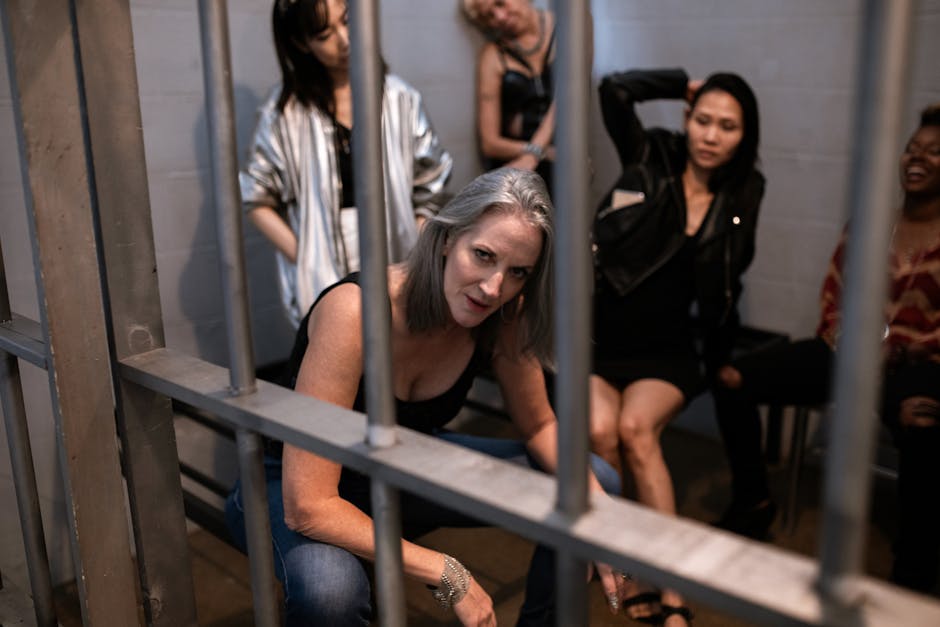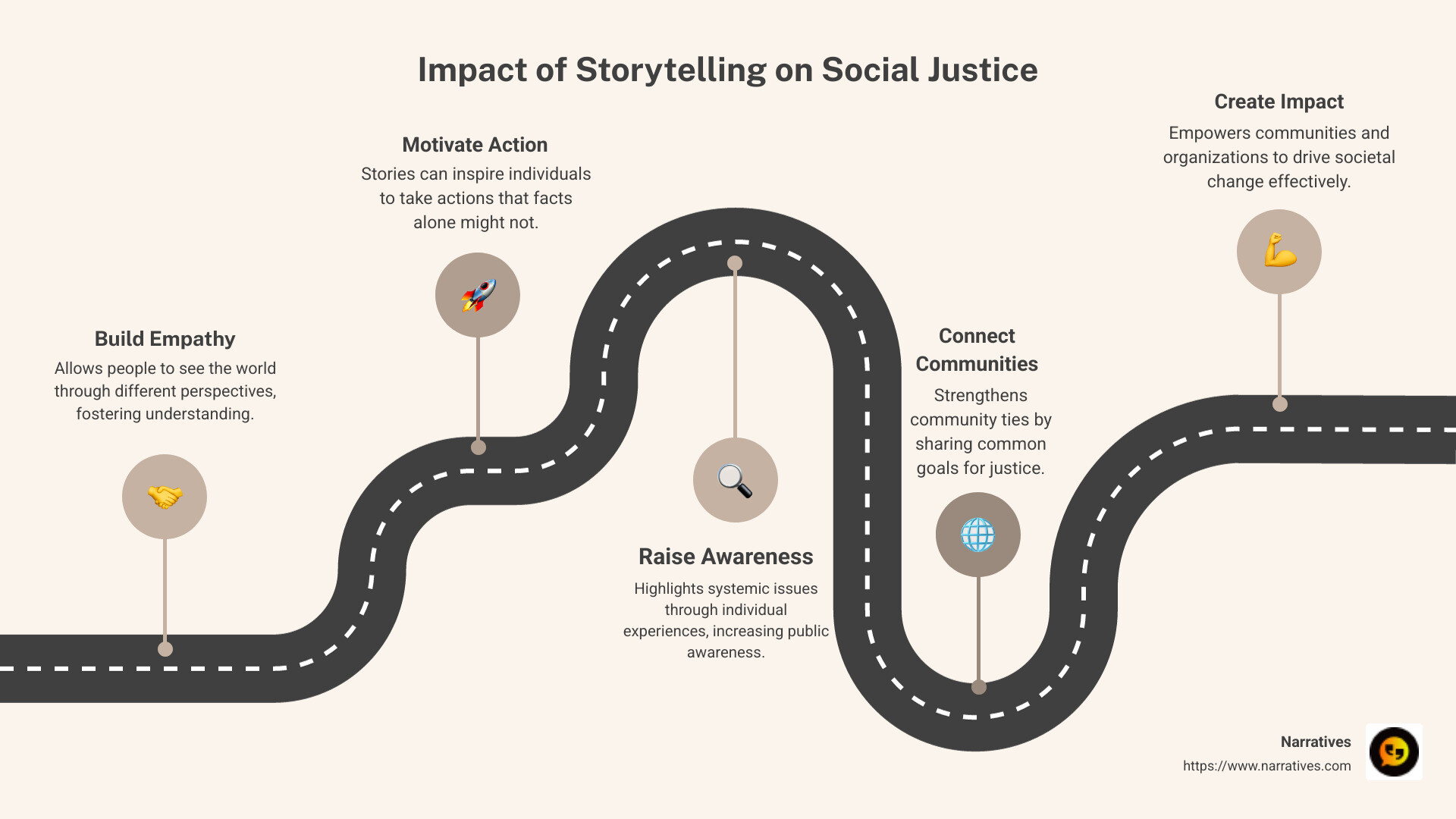Narrative Justice: Harnessing Storytelling for Social Change

Social justice through storytelling is about using the power of stories to inspire change and bring attention to issues of equality and fairness.
Here’s why it's important:
- Stories make complex issues relatable and human.
- They give a voice to those who are often unheard.
- Narratives can expose inequalities and drive action.
In a world inundated with data, stories have the unique power to make statistics personal and meaningful. As noted in the Student Voice Team's insights, "you simply can’t have social justice without storytelling; the greatest movements in history are fueled by it." From Black Lives Matter to climate justice, storytelling is a catalyst for change, revealing the human lives behind the issues.
Why focus on storytelling for social justice?
- Empathy: It builds empathy by allowing others to see the world from different perspectives.
- Action: Stories can motivate people to take action in ways facts alone cannot.
- Awareness: They raise awareness about systemic issues by highlighting individual experiences.
- Connectivity: Storytelling connects individuals and communities, reinforcing the collective fight for justice.
Successfully using the power of storytelling fosters community growth and creates impactful content that resonates deeply with audiences. For non-profit organizations and brands focused on social justice, integrating stories into their strategy not only lifts their mission but also amplifies their voices for broader societal change.

The Power of Storytelling in Social Justice
Storytelling is a powerful tool for promoting social justice. It can drive change by making complex issues understandable and personal. At its core, storytelling is about narratives that champion equity and inclusion.
Why does storytelling matter?
Narrative: Narratives shape our understanding of the world. They help us see beyond statistics to the real people affected by issues. In the fight for social justice, stories highlight the struggles and triumphs of marginalized communities. They reveal inequities and inspire change.
Equity: Stories can level the playing field. They give voice to those who are often unheard and challenge dominant narratives. By sharing diverse perspectives, storytelling promotes equity. It helps us understand the varied experiences of different groups, breaking down stereotypes and biases.
Inclusion: Inclusion is about ensuring everyone feels valued and heard. Storytelling fosters inclusion by celebrating diverse voices and experiences. It connects us to one another, building empathy and understanding across different communities.

How does storytelling achieve these goals?
Building Empathy: Stories allow us to step into someone else's shoes. They help us understand different perspectives and experiences, fostering empathy and compassion.
Motivating Action: A well-told story can inspire action. Unlike facts alone, stories move people emotionally, prompting them to get involved and make a difference.
Raising Awareness: Stories spotlight systemic issues by focusing on personal experiences. They make invisible problems visible, raising awareness and prompting discussions.
Connecting Communities: Storytelling connects people. It brings individuals and communities together, reinforcing the collective effort needed for social justice.
For organizations and individuals committed to social change, incorporating storytelling into their work is essential. It not only amplifies their mission but also engages audiences in meaningful ways, driving progress toward a more just society.
Social Justice Through Storytelling: Key Approaches
To harness the power of storytelling for social justice, we need to focus on a few key approaches. These include oral history, trauma-informed methods, and cultural awareness. Let's explore how each of these contributes to the broader narrative of equity and inclusion.
Oral History
Oral history is a powerful form of storytelling. It's about capturing and sharing the lived experiences of individuals, especially those from marginalized communities. This approach allows us to document stories that might otherwise remain untold.
- Why Oral History? It brings depth and authenticity to the narrative. Personal stories make abstract issues tangible, helping others understand the real impact of social injustices.
Trauma-Informed Practices
When dealing with sensitive topics, it's crucial to use trauma-informed practices. This means being aware of the potential emotional impact on both the storyteller and the listener.
Key Considerations:
- Consent: Always obtain informed consent. Ensure participants understand how their stories will be used.
- Safety: Create a safe space for sharing. Be mindful of triggers and provide support if needed.
Why Trauma-Informed? It respects and protects the emotional well-being of participants. This approach builds trust and encourages honest storytelling.
Cultural Awareness
Cultural awareness is about understanding and respecting the diverse backgrounds of storytellers. It means recognizing cultural norms and values and how they shape narratives.
Importance of Cultural Awareness:
- Respect: It ensures stories are told with respect and sensitivity to cultural contexts.
- Authenticity: Culturally aware storytelling captures the true essence of a community's experiences.
Example: In the Student Voice Team, discussions emphasize the importance of combining data with personal stories to reveal systemic issues. This approach helps to connect individual experiences with broader social justice efforts.
By focusing on these key approaches, storytelling becomes a tool for promoting equity and inclusion. It amplifies marginalized voices, fosters empathy, and drives meaningful change in the pursuit of social justice.
Next, we'll explore the different types of stories that play a role in social justice efforts.
Types of Stories in Social Justice
In the field of social justice through storytelling, different types of stories serve unique purposes. Let's dig into three primary types: stock stories, concealed stories, and counter stories.
Stock Stories
Stock stories are the narratives most commonly told in society. They often reflect dominant cultural norms and can perpetuate stereotypes or reinforce existing power structures.
Characteristics:
- Typically told by those in power.
- Often omit the experiences and voices of marginalized communities.
- Can uphold systemic inequalities.
Example: In educational settings, stories that highlight only the achievements of certain groups while ignoring others can perpetuate a narrow view of success and capability.
Concealed Stories
Concealed stories are those that exist but are not widely shared. They are often suppressed or overlooked in mainstream narratives.
Purpose:
- To reclaim subjugated memory and knowledge.
- To provide a more complete picture of history and current events.
Example: Kayhan Irani's work on "Unpacking History Through Place-Based Learning" reveals concealed stories of Asian American resistance, offering a deeper understanding of their contributions and struggles.
Counter Stories
Counter stories are narratives that challenge dominant stock stories. They offer alternative perspectives and highlight the experiences of marginalized groups.
Importance:
- They resist and redefine the narratives imposed by stock stories.
- They create space for dialogue and understanding.
Example: Lauren Anderson's essay "Resisting Stock Stories and Learning to Teach Courageously" exemplifies how educators can use counter stories to challenge traditional narratives and foster a more inclusive learning environment.
By understanding and using these types of stories, we can better address social injustices and promote a more equitable society. Each type plays a crucial role in reshaping narratives and amplifying the voices that need to be heard.
Next, we'll look at best practices for ensuring that storytelling in social justice is conducted ethically and effectively.
Best Practices for Social Justice Storytelling
When engaging in social justice through storytelling, follow best practices to ensure ethical and effective storytelling. Here are some key considerations: consent, power dynamics, and self-care.
Consent
Consent is the foundation of ethical storytelling. It means getting permission from individuals to share their stories.
Why It Matters:
- Respects the autonomy and dignity of the storyteller.
- Ensures stories are shared willingly and accurately.
How to Obtain Consent:
- Clearly explain how the story will be used.
- Allow storytellers to set boundaries on what they want to share.
- Provide the option to withdraw consent at any time.
Power Dynamics
Understanding power dynamics is crucial to avoid exploiting or misrepresenting storytellers, especially those from marginalized communities.
Recognizing Power Imbalances:
- Be aware of who holds the power in the storytelling process.
- Acknowledge cultural, social, and economic differences between storytellers and those sharing their stories.
Mitigating Power Imbalances:
- Involve storytellers in decision-making processes.
- Ensure their voices and perspectives are prioritized.
- Use trauma-informed practices to create a safe and supportive environment.
Self-Care
Storytelling, especially about social justice issues, can be emotionally taxing for both storytellers and listeners. Prioritizing self-care is essential.
For Storytellers:
- Encourage breaks and provide mental health resources.
- Foster a supportive community where they can share experiences without judgment.
For Listeners and Facilitators:
- Practice active listening without imposing personal biases.
- Be mindful of emotional responses and seek support if needed.
By adhering to these best practices, we can ensure that storytelling in social justice is both impactful and respectful. This approach not only amplifies marginalized voices but also fosters a more inclusive and equitable narrative landscape.
Next, we'll address some frequently asked questions about social justice through storytelling.
Frequently Asked Questions about Social Justice Through Storytelling
How does storytelling promote social justice?
Storytelling is a powerful tool for promoting social justice because it humanizes data and statistics. It brings to light the personal experiences behind systemic issues. Through stories, we can better understand the complexities of social injustices and the real people affected by them. This understanding fosters empathy and drives change.
Narrative as a Bridge: Storytelling connects diverse communities by highlighting shared experiences and struggles. It encourages dialogue and understanding, which are crucial for creating equitable solutions.
Empowerment Through Voice: When marginalized individuals share their stories, they reclaim power over their narratives. This can challenge stereotypes and dismantle biases.
Mobilizing Action: Stories are catalysts for action. Movements like Black Lives Matter have shown how personal stories can galvanize public support and drive policy changes.
What are some examples of social justice storytelling?
Numerous initiatives demonstrate the impact of storytelling in social justice. Here are a few notable examples:
The Storytelling Project Model: Developed by LA Bell and colleagues, this model uses narrative and arts to teach about race, racism, and social justice. It encourages the creation of counter-narratives to resist systemic biases.
Hollaback! Movement: This initiative uses storytelling as feminist pedagogy, allowing individuals to share experiences of harassment and advocate for safer spaces.
Digital Storytelling for Social Justice Education: Students use digital platforms to share stories, promoting awareness and understanding of social justice issues.
How can organizations implement storytelling for social change?
Organizations can harness storytelling to drive social change by following these steps:
Create a Safe Space: Establish environments where individuals feel comfortable sharing their stories without fear of judgment or retribution.
Train Storytellers: Provide training on ethical storytelling practices, focusing on consent and cultural awareness.
Use Diverse Platforms: Leverage various media, such as podcasts, videos, and social media, to reach broader audiences.
Engage the Community: Involve community members in storytelling initiatives to ensure the narratives are authentic and representative.
Monitor Impact: Regularly assess the impact of storytelling efforts to refine approaches and maximize their effectiveness.
By integrating storytelling into their strategies, organizations can amplify marginalized voices and contribute to meaningful social change.
Conclusion
At Narratives, we believe in the transformative power of social justice through storytelling. Our mission is to lift the voices of underrepresented communities and to share their impact stories in a way that inspires action, builds trust, and increases visibility.
Narratives as a Force for Change
Storytelling is more than just sharing experiences; it's about creating a movement. When stories are shared, they become a powerful tool for change. They highlight the challenges faced by communities and the resilience they show in overcoming them. This kind of storytelling fosters understanding and empathy, bridging gaps between different communities and driving social change.
Community-Driven Impact
Our approach is community-driven. We work closely with non-profits and purpose-driven organizations to ensure that the stories we tell are authentic and impactful. By focusing on real experiences and challenges, we help these organizations connect with their audiences on a deeper level, encouraging support and engagement.
Creating Lasting Impact
The stories we help share are not just about raising awareness; they're about creating lasting impact. By highlighting the real people behind social justice issues, we aim to inspire action that leads to tangible change. Whether it's through policy shifts, increased funding for critical programs, or simply changing perceptions, the stories we tell have the power to make a difference.
For organizations looking to harness the power of storytelling for social change, we offer a range of services designed to lift their message and amplify their impact. Learn more about how we can help your organization share its story and drive social change by visiting our service page.
Storytelling is essential in the fight for social justice. At Narratives, we are committed to being the digital storytelling partner that helps bring these crucial stories to light.


